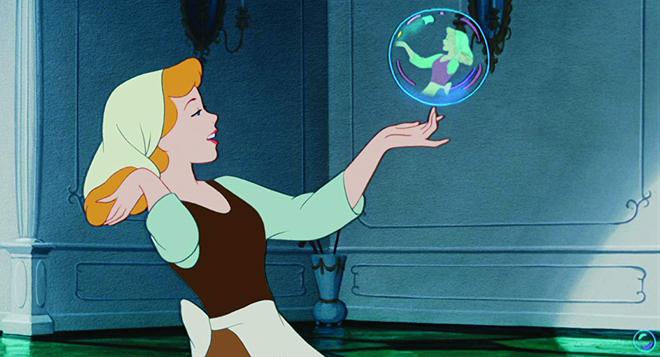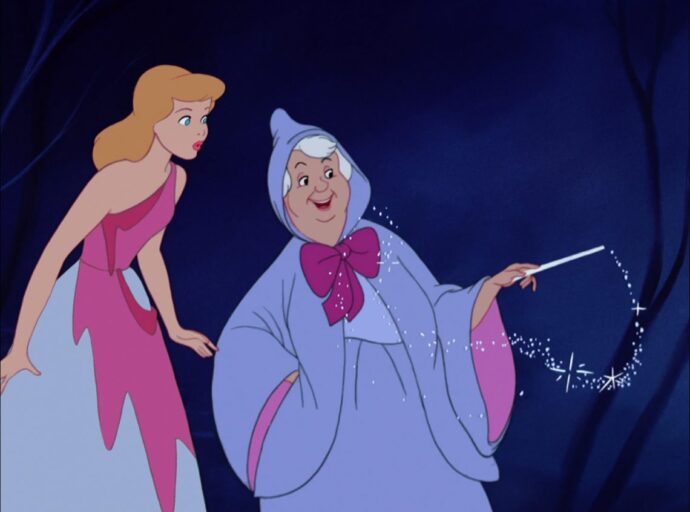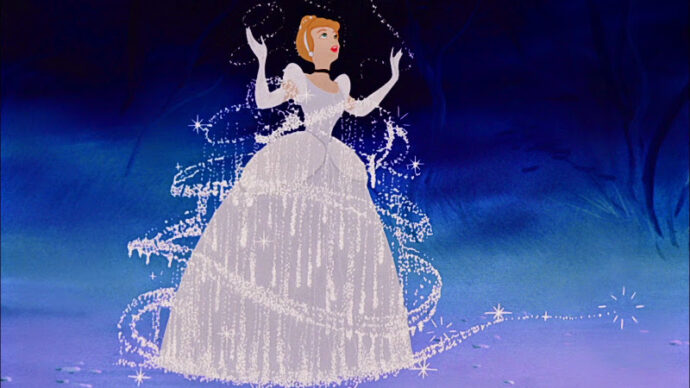Plus or Minus is a series detailing and analyzing every feature film now streaming on Disney+. It combines the unique history all these films share, their cultural impacts, and their qualities, or lack thereof. From timeless classics, to acquired hits, to DCOMs, no stone will be left unturned.
After weeks of cheap package titles, Plus or Minus finally looks at Cinderella, an integral piece to the Disney legacy. Specifically because this silly blog series would not exist without it. The story is one we all know. Cinderella, voiced by Ilene Woods, is a kind, generous, yet lonely woman. After losing her father, she has been forced to work as a maid by her wicked stepmother. Abused by her icy stepmother Lady Tremaine and her immature stepsisters, the only companions she has are a group of animal friends.
But luck soon comes to Cinderella’s way when the king hosts a ball. A ball where the king tries to get his son a wife to be exact. While things may seem down for the young heroine, a helpful Fairy Godmother gives her one chance to go to the ball and possibly find love along the way.
A Literal Rags to Riches Tale
The story of Cinderella is one that Walt Disney always appreciated. One can argue Walt himself is a Cinderella type. But Cinderella also serves as a metaphorical rags to riches for the animation studio. As said before, Disney’s money troubles after Snow White were plentiful. World War II killed the box office for movies like Pinocchio and Bambi. Meanwhile, many of the animators were drafted to fight. This of course caused a massive pile of debt for the animation company. Disney would try to release anthology titles to get extra money, but it was low-risk, low-reward.
This meant it was necessary for Disney to make a Hail Mary film. And thus, Cinderella went into production, serving as a return to form to the likes of Snow White. From its leads to its origins to even its animation style.
Yet Cinderella succeeds as both a traditional and experimental piece that laid the groundwork for future Disney classics. And sure enough, Cinderella exceeds as a heartfelt, beautiful story about perseverance and kindness.
The Values of Cinderella Herself
Disney’s interpretation of the character of Cinderella is a debated one. Some chide her for being one-dimensional and passive. Others value her charming, endearing personality. I am very much in the latter camp here. Helped also by Ilene Woods’ extraordinary performance, Cinderella is the bedrock for why the movie works. While not necessarily proactive, she still works hard and has a strong sense of patience and humor that gives her a touch more character. She’s also a solid audience surrogate, as she reacts to the abuse and extreme situations much like how we would in that situation.

The stuff the overworking Cinderella goes through only helps make the emotional moments even stronger. It’s clear that Cinderella is trying her best to go through these awful situations. A relatable situation for many that allows both the audience to sympathize with her struggles, as well as showcase the values of hard work and perseverance. Her head is still held up high, and she does try to find things to appreciate, believing something good is right around the corner.
This kind of hopefulness might be a touch improbable today, but it’s important to have that kind of faith and hard work with you, and Cinderella, both the film and the character, celebrates that.
Animals, Shrews, and Godmothers
While Cinderella is a debated figure, it’s largely agreed the supporting cast is what makes the film work. And it’s hard not to see why, especially when it comes to the animal companions. The bevy of mice in the film all have adorable designs and fun personalities. They were specifically added to make the film more endearing and manipulate the audience with cuteness. And it succeeds wonderfully, as they bring a likable energy, and even take part in some suspenseful moments. The sequence where the mice Gus and Jaq try to get Lady Tremaine’s key is still a nerve-wracking one. The appropriately-titled cat Lucifer is also a goofy, but still threatening and well-animated antagonist to the rodents.
The other characters are also a blast. The Fairy Godmother is a warm, lively presence, and the King’s obsession over his son and getting grandchildren brings in plenty of laughs. The only real drawback is the Prince himself, who barely even has a personality and is nothing more than a plot device. A bit disappointing, considering how great the rest of the supporting cast is.
But of course what everybody loves are the villains. The selfish, immature stepsisters are a funny duo, but Lady Tremaine is who really shines. Not only are her facial expressions wicked and sharp, her manipulation is subtle yet deadly. She never becomes too cartoonish, but her voice, mannerisms, and actions still permeate throughout the film. Her intelligence is used brilliantly here and it is fun to see what she does next, as she is still a bit unpredictable.
Game-Changing Animation
The look of Cinderella is pretty incredible. The backgrounds make every location seem grand and gigantic, making Cinderella’s predicament all the more powerful. And there’s a unique abstractness to the backgrounds, helped by Mary Blair’s great concept art and the incoming Modernist movement. This was an interesting look for Disney back then and works really well. The lighting also helps give the film a unique feel, with shadows and darkness emphasizing Cinderella’s loneliness and Lady Tremaine’s frosty stare. It brings the needed emotion and tenseness to these scenes and sticks out as an unforgettable image.
The character designs are also very solid. There’s softer colors and a softer animation style similar to Snow White here, notably with Cinderella and the Prince. Disney used reference guides for these characters, giving them a more realistic look that isn’t as memorable as other Disney characters, but still nice to look at. While other human characters have a bit more of a cartoony look, and the animals stay purposely exaggerated, characters like Lady Tremaine and the King still have naturalistic movements to them, though they are still allowed to exaggerate themselves.

In a way, Cinderella defined the look for Disney’s Silver Age, the era when the Disney brand truly came into form. Realistic-looking lead characters with some over-the-top human designs thrown in paired up with goofy-looking animals, with some abstract backgrounds and colors. This would be the main look for films like Peter Pan and The Jungle Book, and it’s a simple, yet effective formula that allows the animators to truly have fun, innovate, and be creative. And even today, Cinderella’s memorable colors and animated set pieces still serve as some of the best that Disney has to offer.
The Best Disney Music (Fight Me)
What is considered the best, most iconic Disney soundtrack is up in the air and varies from person to person. And while I can’t give my own definitive answer, Cinderella certainly comes close. “So This is Love” is heavenly to listen to, while “Bibbidi Bobbidi Boo” has many clever rhymes and a fun rhythm. “The Work Song” is a cute little bop of a number, and “Sing Sweet Nightingale” has a humorous introduction that soon leads to a gorgeous, somewhat surreal second half.
Yet the best number is “A Dream is a Wish Your Heart Makes”. Opening up the film as Cinderella starts the day, this is simply an iconic track. The lyrics are gorgeously written, talking about the beauty of dreams and how we can use them as goals. There’s a fantasy edge to the whole piece, yet also still feels believable in its message and writing. And of course, Ilene Woods performs this beautifully. Her voice is smooth as silk, and each lyric she sings is full of passion and joy. The very idea of dreams gives Woods such an amazing spark.
If I can speak personally, “A Dream is a Wish Your Heart Makes” is my favorite Disney song. One of my favorite songs of all time in fact. It has an inspirational, heartfelt message about the importance of dreams, no matter how fanciful they may be. The world can be cynical and frustrating, and it’s important to deal with that. But it’s through our dreams we find joys and ideas on how things can get better. And with enough hard work and kindness, those dreams come true. This has been a tune that’s been in my head for as long as I can remember and it will always be an inspirational piece for me.
Plus or Minus?
The reason why I started Plus or Minus is a number of reasons. I have a strong interest in The Walt Disney Company and this is a bit of a nostalgic trip towards what introduced me to film. Since starting Plus or Minus, Cinderella is the film I’m most nostalgic for. Ever since I was young, the colors, characters, and music always got me emotional and full of serotonin. The animation is gorgeous, the characters are memorable, the songs are perfect, and it always left me in a good mood after watching. And even today, the film’s message of hopefulness are a necessary one for me and many others.
It’s a film that is intensely feel-good without ever feeling patronizing and it will always have a place in my heart. Sure, it might be slow to some, but everything here works perfectly for me, and shows how talented Disney’s animation team was back in the day.
So yeah, if I had to choose Plus or Minus, Cinderella is a very strong, very enthusiastic Plus. This was a great start to the 1950s, and it’s exciting to see what will happen next.
NEXT TIME: Disney finally goes into live-action with Treasure Island. Can this continue the cinematic high that was Cinderella?
